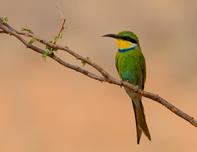
Name
Swallow-tailed bee-eater (Merops hirundineus)Appearance
The swallow-tailed bee-eater is bright green on top with a green breast and a pale blue lower belly. A blue gorget (collar) separates the green breast from a pale yellow throat.The tail is deeply forked and blue in colour. Like all bee-eaters, the swallow-tailed bee-eater has a black eye stripe, with turquoise spot above the eye.
Diet
The swallow-tailed bee-eater hunts flying insects in flight. Once they catch an insect, they will return to a perch to kill the insect and remove its sting, by repeatedly hitting the insect against the branch. The swallow-tailed bee-eaters preferred insects are bees.Swallow-tailed Bee-eater Breeding
A tunnel is dug by both the male and female swallow-tailed bee-eater, normally in an inclined sandy bank or an aardvark hole. This tunnel can be as deep as 100 cm. They do not line the nest cavity and the 2 to 4 eggs are laid directly on the sand. This bee-eater is parasitized by the Greater Honeyguide (Indicator indicator).Swallow-tailed Bee-eater Behaviour
The swallow-tailed bee-eater will roost communally at night, with the birds huddled together on a single perch, outside of the breeding season. They often use the same perch repeatedly when hunting, doing short flights to catch prey then returning to the same perch.Outside of the breeding season, they are normally found in small flocks of eight to ten birds.